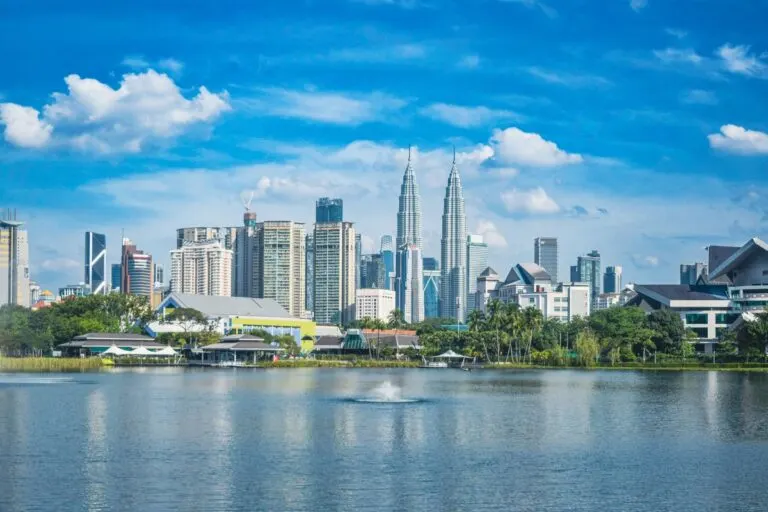For the last couple of years, Bangkok has become a digital nomad capital of sorts in Asia, and many have attributed its success to a low cost of living–according to Nomad List, living there costs an average of $1,398 a month–and a lively social scene.
It’s truly hard to beat Bangkok’s infamous Sukhumvit Soi 11 when it comes to nightlife or rival the backpacker scene of Silom, but it seems as if there’s a new workcation hotspot in the Orient seeing a significant influx of remote workers as of late.
Though still not nearly as popular as its Thai counterpart, Kuala Lumpur in Malaysia is steadily rising up the digital nomad charts, and it’s not like we hadn’t seen it coming:
Is Kuala Lumpur Asia’s Next Nomad Haven?

Ahead of getting to the actual good stuff, the stuff that matters most to digital nomads, one thing you should know about Kuala Lumpur is that it is among the best-developed conurbations in Asia, with relatively good infrastructure, functional transport, and higher living standards:

According to the Economic Intelligence Unit’s Global Livability Index, it ranks 70th worldwide, and 2nd in Southeast Asia after Singapore, and to all effects and purposes, it’s a perfectly-inhabitable 21st-century metropolis.
Now onto the most exciting bit:
Modernism vs Tradition
While there’s room for debate over whether Kuala Lumpur is indeed one of the most vibrant cities in Asia, there’s no denying it’s an innovation hub:

For instance, the skyline is dominated by a duo of identical towers called Petronas, topped with Islamic motifs.
Though Dubai’s Burj Khalifa claims the title of the tallest in the world, Kuala Lumpur’s duo is the tallest twin set.
Unlike other Southeast Asian capitals that have sacrificed their green spaces in their quest for development, Malaysia’s rising star has managed to integrate them into an urban ecosystem, as seen with the centrally-located Perdana:
A Botanical Garden criss-crossed by footpaths and dotted with scenic ponds, it allows residents––and visiting nomads alike––an escape from the oppressive Southeast Asian heat and hectic traffic while still having endless rows of skyscrapers for backdrop.
If you’re a nomad relocating from America or Europe to Asia, you’re probably looking for a higher quality of life, and a healthier lifestyle away from the hustle and bustle of your home city––let’s face it, Kuala Lumpur is no quaint village, but it does offer some respite.
Thriving Multiculturalism
Compared to sprawling Bangkok, it’s much smaller and thus less crowded.
Most importantly, motorbikes don’t rule the streets: yes, traffic may get congested at peak hours, but a Grab (local Uber) is not the only way to get around.
There are plenty of pedestrian-friendly zones, spacious sidewalks, and car-free walkways, as well as miles upon miles of cycling lanes and extensive, effective public transportation that make it easier for guests to get from point A to B hassle-free.
Other than its fascinating contrasts, Kuala Lumpur’s multiculturalism is just as big a draw for long-term guests:
It’s a place where tradition and modernism constantly clash, including at the confluence of the Gombak and Klang rivers, where a historic Jamek Mosque sits, flanked on both sides by a series of steel-and-glass-clad high-rises.
From British colonial buildings like the Central Railway Station to the monumental Masjid Negara, a mosque with a unique umbrella-shaped roof, to the Thean Hou Temple, one of the most ornate Chinese shrines outside China, it almost feels like several different cities in one.
Why Nomads Love Kuala Lumpur
On top of the cultural attractions, the Malaysian capital is packed with laptop-friendly cafes, ensuring stable Wi-Fi and a pleasant environment for the week.
Not to mention, it is extremely safe by global standards, enjoying moderate to low crime levels.
On the cafe front, notable examples are VCR Cafe, in the heart of the busy Bukit Bintang shopping district, Leaf & Co, a tried-and-true nomad haven specializing in cappuccino and bite-sized eats, and our personal favorite, the three-story Malaya Garden, featuring an indoor rooftop.
Regarding the latter, Malaysia is one of a handful of destinations worldwide, and the U.S. State Department has added it to its Level 1 Travel Advisory list, meaning it is equivalent to Iceland, Finland, Switzerland, and the like.
Affordable Stays
The affordable Airbnb listings are yet another big draw for potential future residents, with one-month stays starting from as cheap as $235 and an entire flat with access to a sky pool and gym costing $681 to book for the entire month this fall.
Overall, Nomad List estimates show that nomads spend an average $1,271 per month working remotely from Kuala Lumpur––with the high affordability, abundance of coworking spots and cheap rent, it’s no surprise the same platform ranked it as the preferred destination by nomads last December.
To support Nomad List‘s findings, Remote (a global Human Resources platform) confirmed Kuala Lumpur jumped from 84th place to 22nd in the latest yearly list of Top 100 Destinations For Remote Work: that’s a whole 62 slots in one year.
Last but certainly not least, Kuala Lumpur benefits from its parent country’s relaxed visa policy:
Unlike other destinations in Asia like Vietnam or Bali, Malaysia does not require U.S. citizens to apply for a visa, eVisa, or any other form or entry permit ahead of flying; in addition, Americans can stay a whole 3 months visa-free, while in other Asian countries they must leave after 30 to 60 days.
You read more about Kuala Lumpur––and Malaysia as a whole––clicking here.
Credit: Source link








